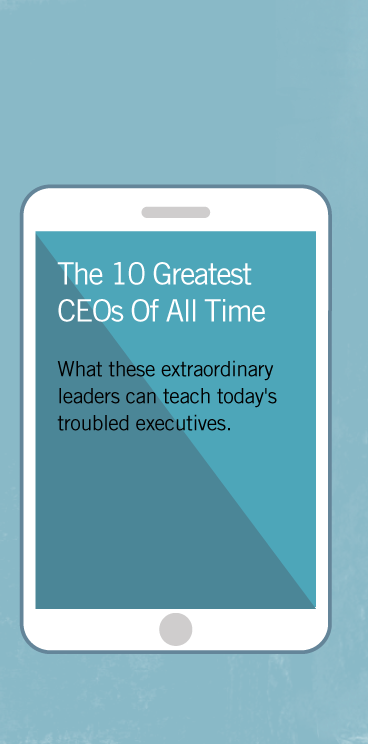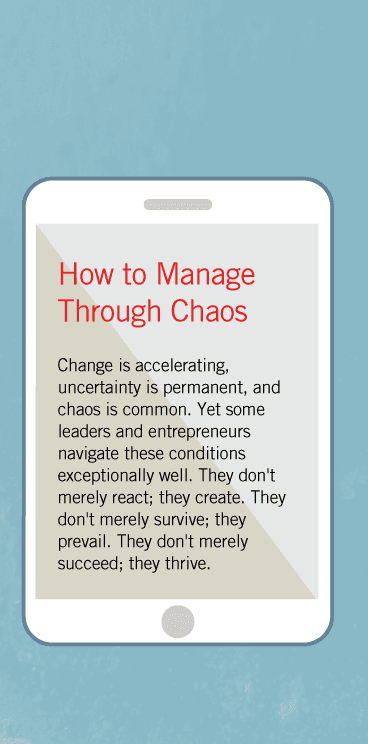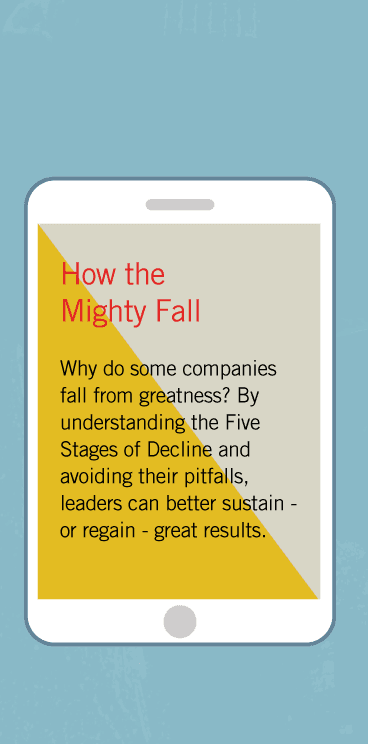Companies Need Not Hire Outside CEOs
to Stimulate Fundamental Change
Directorship
October 1994
Drawing upon a six-year research project at Stanford University
Graduate School of Business, we took eighteen truly exceptional
and long-lasting companies—they have an average age of nearly
100 years, outperforming the general stock market by over fifteen
times since 1926—and studied each company in direct comparison
to one of its top competitors. We examined the companies from
their very beginnings to the present day—as start-ups, as
mid-sized companies, and as large corporations.
In our research, we sought to answer one basic question: What makes the truly exceptional companies different from other companies? What has consistently separated companies like General Electric, 3M, Motorola, Johnson & Johnson, Boeing, Wal-Mart, Hewlett Packard, Procter & Gamble, Walt Disney, and Philip Morris from their rivals?
Our main objective was to go beyond the incessant barrage of management buzzwords and fads of the day to discover timeless qualities that consistently distinguish outstanding companies, and to translate these findings into a useful framework of practical concepts that managers and directors can apply. We came to call these premier and long-lasting institutions "visionary companies."
Our work, which culminated in the new book BUILT TO LAST: Successful Habits of Visionary Companies (HarperBusiness, 1994), shattered numerous widely-held management myths. (See sidebar article). One of the most powerful myths called into question by our research is that companies should seek to hire CEOs from the outside in order to stimulate fundamental change.
In seventeen hundred years of combined lifespans, we found only four individual incidents of going outside for a CEO—and those in only two companies. (Results date to 1992). Homegrown management rules at the visionary companies to a far greater degree than at the less-successful comparison companies (by a factor of over six times). Simply put, there is absolutely no inconsistency between promoting from within and stimulating significant change. Visionary companies have shown, time and again, that they do not need to hire top management from the outside in order to get change and fresh ideas. Equally important, our research shows why it is extraordinarily difficult to become and remain a highly visionary company by hiring top management directly from outside the organization.
Consider the case of Jack Welch and The General Electric Company. In 1981, Welch became chief executive of GE. A decade later, he had become legendary in his own time, "widely acknowledged," according to Fortune magazine, "as the leading master of corporate change in our time." To read the myriad of articles on Welch's revolution, we might be tempted to picture him as a savior riding in on a white horse to rescue a severely troubled company that had not changed significantly since the invention of electricity. If we did not know Welch's background or GE's history, we might be lured into thinking that he must have been brought in from the outside as "new blood" to shake up a lumbering, complacent behemoth.
For one thing, Welch was pure GE home-grown stock, having joined the company directly out of graduate school one month before his 25th birthday. It was his first full-time job, and he worked at GE for twenty consecutive years before becoming chief executive. Like every single one of his predecessors, Welch came from deep inside the company.
Nor did Welch inherit a grossly mismanaged company. Quite the opposite. Welch's immediate predecessor, Reginald Jones, retired as "the most admired business leader in America." Furthermore, Welch is not the first change agent or management innovator in GE's panoply of home-grown chief executives. Under Gerard Swope (1922-1939), GE moved dramatically into home appliances. Swope also introduced the idea of "enlightened management"—new at the time to GE—with balanced responsibilities to employees, shareholders, and customers. Under Ralph Cordiner (1950-1963) and his slogan "Go for it," GE exploded into a vast array of new arenas. Cordiner radically restructured and decentralized the company, instituted management by objective (one of the first companies in America to do so), created Crotonville (GE's now-famous management training and indoctrination center), and wrote the influential book New Frontiers for Professional Managers. Fred Borch's tenure (1964-1972) was "a time of creative ferment" and a willingness to make bold, risky investments in such areas as jet aircraft engines and computers. Reginald Jones (1973-1980) became a leader in changing the relationship between business and government.
Indeed, Welch comes from a long heritage of managerial excellence atop GE. Using pre-tax Return On Equity (ROE) as a basic benchmark of financial performance, GE under Welch's predecessors performed as well on average since 1915 as GE during Welch's first decade in office.
This in no way detracts from Welch's immense achievements. He ranks as one of the most effective Chief Executive Officers in American business history. But—and this is the crucial point—so do his predecessors. Welch changed GE. So did his predecessors. Welch outperformed his counterparts at Westinghouse. So did his predecessors. Welch became widely admired by his peers—a "management guru" of his age. So did his predecessors. Welch laid the groundwork for the future prosperity of GE. So did his predecessors. We respect Welch for his remarkable track record. But we respect GE even more for its remarkable track record of continuity in top management excellence over the course of 100 years. To have a Welch-caliber CEO is impressive. To have a century of Welch-caliber CEOs all grown from inside—well, that is one key reason why GE is a visionary company.
In short, it is not the quality of leadership that separates visionary companies like GE from less successful companies over the long term. It is the continuity of quality leadership that matters—continuity that preserves the core values and purpose of the institution while simultaneously stimulating progress into the future. Both the visionary companies and the comparison companies in our research study had excellent top management at certain points in their histories. But the visionary companies had better management development and planning. They thereby ensured greater continuity in leadership talent grown from within than the comparison companies in 15 out of 18 cases.
If you're the chief executive or board member at a large company, your company should have management development processes and long-range succession planning in place to ensure a smooth transition from one generation to the next. The key is to develop and promote insiders who are highly capable of stimulating healthy change and progress, while preserving the enduring core ideology of the institution. They are there, you just need to find and develop them.
From the perspective of building a visionary company, the issue is not only how well the company will do during the current generation. The crucial question is: How well will the company perform in the next generation, and the generation after that, and the generation after that? And so on. All individual leaders—all outside "saviors"—eventually retire. But a visionary company can tick along for centuries, pursuing its purpose and expressing its core values long beyond the tenure of any individual leader. In order to achieve this, the company must have the ability to attract, select, retain, train, develop, and promote superb managerial talent from within.
In our research, we sought to answer one basic question: What makes the truly exceptional companies different from other companies? What has consistently separated companies like General Electric, 3M, Motorola, Johnson & Johnson, Boeing, Wal-Mart, Hewlett Packard, Procter & Gamble, Walt Disney, and Philip Morris from their rivals?
Our main objective was to go beyond the incessant barrage of management buzzwords and fads of the day to discover timeless qualities that consistently distinguish outstanding companies, and to translate these findings into a useful framework of practical concepts that managers and directors can apply. We came to call these premier and long-lasting institutions "visionary companies."
Our work, which culminated in the new book BUILT TO LAST: Successful Habits of Visionary Companies (HarperBusiness, 1994), shattered numerous widely-held management myths. (See sidebar article). One of the most powerful myths called into question by our research is that companies should seek to hire CEOs from the outside in order to stimulate fundamental change.
In seventeen hundred years of combined lifespans, we found only four individual incidents of going outside for a CEO—and those in only two companies. (Results date to 1992). Homegrown management rules at the visionary companies to a far greater degree than at the less-successful comparison companies (by a factor of over six times). Simply put, there is absolutely no inconsistency between promoting from within and stimulating significant change. Visionary companies have shown, time and again, that they do not need to hire top management from the outside in order to get change and fresh ideas. Equally important, our research shows why it is extraordinarily difficult to become and remain a highly visionary company by hiring top management directly from outside the organization.
Consider the case of Jack Welch and The General Electric Company. In 1981, Welch became chief executive of GE. A decade later, he had become legendary in his own time, "widely acknowledged," according to Fortune magazine, "as the leading master of corporate change in our time." To read the myriad of articles on Welch's revolution, we might be tempted to picture him as a savior riding in on a white horse to rescue a severely troubled company that had not changed significantly since the invention of electricity. If we did not know Welch's background or GE's history, we might be lured into thinking that he must have been brought in from the outside as "new blood" to shake up a lumbering, complacent behemoth.
Nothing could be further from the truth
For one thing, Welch was pure GE home-grown stock, having joined the company directly out of graduate school one month before his 25th birthday. It was his first full-time job, and he worked at GE for twenty consecutive years before becoming chief executive. Like every single one of his predecessors, Welch came from deep inside the company.
Nor did Welch inherit a grossly mismanaged company. Quite the opposite. Welch's immediate predecessor, Reginald Jones, retired as "the most admired business leader in America." Furthermore, Welch is not the first change agent or management innovator in GE's panoply of home-grown chief executives. Under Gerard Swope (1922-1939), GE moved dramatically into home appliances. Swope also introduced the idea of "enlightened management"—new at the time to GE—with balanced responsibilities to employees, shareholders, and customers. Under Ralph Cordiner (1950-1963) and his slogan "Go for it," GE exploded into a vast array of new arenas. Cordiner radically restructured and decentralized the company, instituted management by objective (one of the first companies in America to do so), created Crotonville (GE's now-famous management training and indoctrination center), and wrote the influential book New Frontiers for Professional Managers. Fred Borch's tenure (1964-1972) was "a time of creative ferment" and a willingness to make bold, risky investments in such areas as jet aircraft engines and computers. Reginald Jones (1973-1980) became a leader in changing the relationship between business and government.
Indeed, Welch comes from a long heritage of managerial excellence atop GE. Using pre-tax Return On Equity (ROE) as a basic benchmark of financial performance, GE under Welch's predecessors performed as well on average since 1915 as GE during Welch's first decade in office.
Management guru
This in no way detracts from Welch's immense achievements. He ranks as one of the most effective Chief Executive Officers in American business history. But—and this is the crucial point—so do his predecessors. Welch changed GE. So did his predecessors. Welch outperformed his counterparts at Westinghouse. So did his predecessors. Welch became widely admired by his peers—a "management guru" of his age. So did his predecessors. Welch laid the groundwork for the future prosperity of GE. So did his predecessors. We respect Welch for his remarkable track record. But we respect GE even more for its remarkable track record of continuity in top management excellence over the course of 100 years. To have a Welch-caliber CEO is impressive. To have a century of Welch-caliber CEOs all grown from inside—well, that is one key reason why GE is a visionary company.
In short, it is not the quality of leadership that separates visionary companies like GE from less successful companies over the long term. It is the continuity of quality leadership that matters—continuity that preserves the core values and purpose of the institution while simultaneously stimulating progress into the future. Both the visionary companies and the comparison companies in our research study had excellent top management at certain points in their histories. But the visionary companies had better management development and planning. They thereby ensured greater continuity in leadership talent grown from within than the comparison companies in 15 out of 18 cases.
If you're the chief executive or board member at a large company, your company should have management development processes and long-range succession planning in place to ensure a smooth transition from one generation to the next. The key is to develop and promote insiders who are highly capable of stimulating healthy change and progress, while preserving the enduring core ideology of the institution. They are there, you just need to find and develop them.
From the perspective of building a visionary company, the issue is not only how well the company will do during the current generation. The crucial question is: How well will the company perform in the next generation, and the generation after that, and the generation after that? And so on. All individual leaders—all outside "saviors"—eventually retire. But a visionary company can tick along for centuries, pursuing its purpose and expressing its core values long beyond the tenure of any individual leader. In order to achieve this, the company must have the ability to attract, select, retain, train, develop, and promote superb managerial talent from within.
Copyright © 1994 Jim Collins and Jerry I. Porras, All rights reserved.






